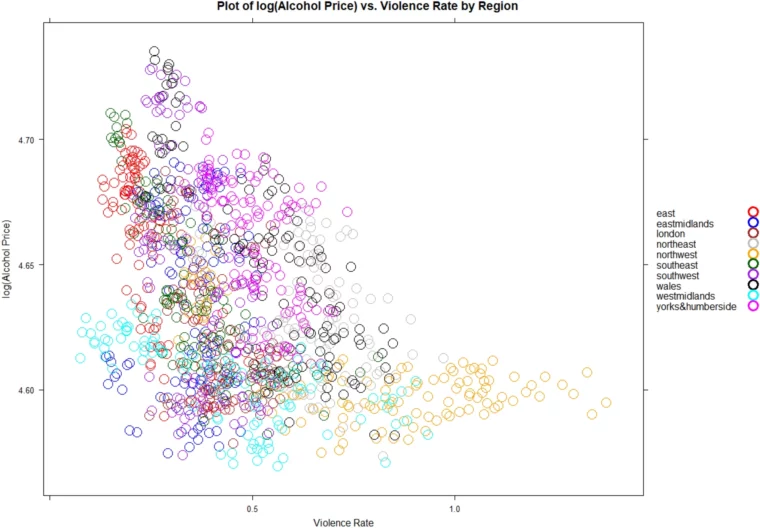
What has the general price of alcohol got to do with the rate of violent injury? It turns out – quite a lot. It is well-accepted that there is a link between alcohol consumption and violence, but epidemiologists have struggled to establish a causal link. While it is well-known that intemperate consumption of alcohol can lead to violent behaviour, and it is also the case that violent people may also drink a lot of alcohol, but also violence and alcohol use disorder may share a common unobserved pathology. Causation is directly or indirectly two-way. However, there is a well-established link between the price of alcohol and the consumption of alcohol – indeed it is a necessary condition of the first law of demand – but it would be hard to explain why violent behaviour could influence the price of alcohol. And therefore any established link between the two must define a causal chain that runs from the price of alcohol to alcohol consumption, and from alcohol consumption through to violent injury.
Data
It is on the basis of this type of reasoning that in the study ‘Alcohol Prices, the April effect, and the Environment, in Violence-related Injury in England and Wales’ the following data are used to estimate an empirical model: monthly hospital data of violent injury attendances at Emergency Departments (EDs) from each of the economic regions of England and Wales for the period 2005-2014, and regional on-sales retail price data of types of alcohol (beer, lager, wine, spirits) from the Office for National Statistics.
The scatter plot below shows that there is a clear negative relationship between regional violence injury rates and the general price of alcohol constructed from the prices of different types of alcohol. But there is also considerable regional and temporal variation in the data that allows room for many other local factors to explain the spread of regional violence injury rates.

Alcohol Duties
Such a simple correlation as in the figure above has an intuitive appeal and may not be a surprise to many. However, to establish a strong link between alcohol price and violent injury it is necessary to build into the model external impulse factors that affect the latter through the former. The uprating of alcohol duties in the Chancellor’s budget statement is one such external impulse.
In April of every year, the Budget statement is used to uprate alcohol duties and therefore there should be a significant ‘April effect’ that sees a dip in violent injury rates allowing for all other the factors. Such an ‘April effect’ was found to be statistically significant. Usually, alcohol duties are uprated to keep up with general inflation, with some variation reflecting differences in alcohol type, but in the 2008 Budget alcohol duties were increased by 6% well above the prevailing rate of inflation. This event represented an additional impulse that would be expected to depress violence injury rates, again allowing for all other factors. The April effect and the April 2008 effect identify that alcohol duties exert an independent effect on violence injury through the rise in alcohol prices.
Digging deeper
Clearly, alcohol prices are not the only factor that drives violence injury. Socio-economic factors that capture local conditions (youth unemployment, inequality, house prices) also matter as do environmental factors (the weather measured by average rainfall in the month/region and the average temperature).
However, digging deeper into the data reveals several interesting facets. First, it turns out that while the ‘April effect’ exists with all types of alcohol, the responsiveness of violence injury to a price change is strongest with spirits, while the price of wine has no effect on violence injury. There is also a significant gender difference. Separating the data into male and female violence injury rates reveals that male violence rates are strongly responsive to changes in the price of beer and spirits but not wine. Whereas female violence rates are responsive only to changes in the price of spirits and nearly three times less than males. This latter finding suggests that the female violence injury rate (which will include domestic violence) is less to do with alcohol prices and more to do with other factors.
Conclusion
The purist may argue that if violence injury is caused by excess alcohol consumption, the best solution is to raise the price of violence, instead of affecting all drinkers by raising alcohol duties – including those who don’t engage in violence. The problem with this argument is that raising the price of violence involves far more state resources than simply increasing the price of alcohol. What would be the implication of increasing alcohol duties above the rate of inflation permanently? A 1% permanent increase in the general price of alcohol reduces ED attendances at hospitals in England and Wales by approximately 7,000 a year.
The take-home message of the research is that raising the price of alcohol above the rate of inflation through alcohol duties will reduce the rate of violence injury attendances at EDs and reduce the costs of pressing health and social problems. Added to this is the reduced psychological costs of violence on the victims. Raising duties on alcohol prices may be a small price to pay by the many moderate drinkers to reduce the costs created by the drinkers that cause such violence.
Written by Professor Kent Matthews, Cardiff Business School.
All IAS Blogposts are published with the permission of the author. The views expressed are solely the author’s own and do not necessarily represent the views of the Institute of Alcohol Studies.
